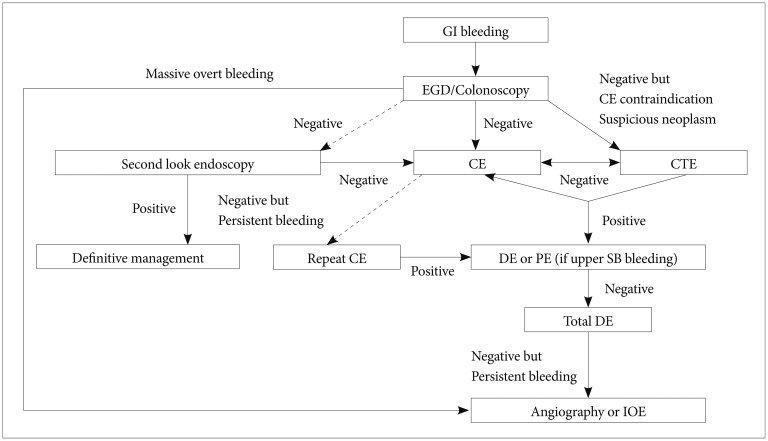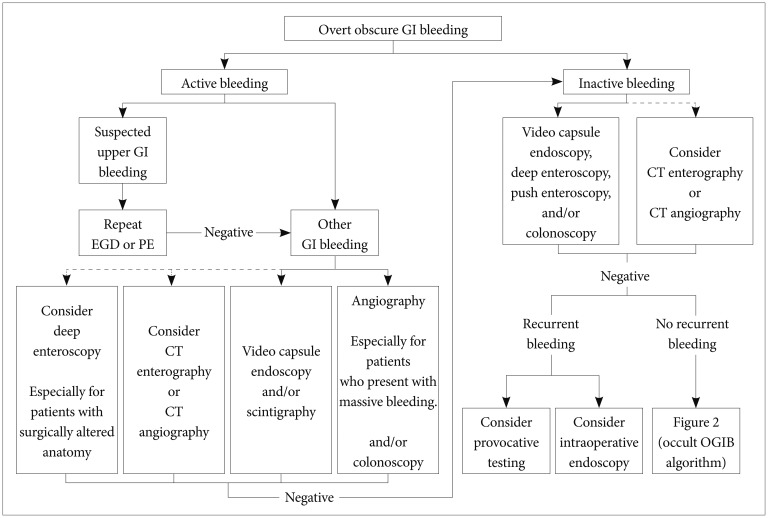Clin Endosc.
2014 Sep;47(5):409-414. 10.5946/ce.2014.47.5.409.
Should Capsule Endoscopy Be the First Test for Every Obscure Gastrointestinal Bleeding?
- Affiliations
-
- 1Department of Internal Medicine, Ewha Womans University School of Medicine, Seoul, Korea. shimkn@ewha.ac.kr
- KMID: 2165371
- DOI: http://doi.org/10.5946/ce.2014.47.5.409
Abstract
- Obscure gastrointestinal bleeding (OGIB) refers to gastrointestinal (GI) bleeding of unclear origin that persists or recurs after negative findings on esophagogastroduodenoscopy and colonoscopy. OGIB accounts for approximately 5% of all types of GI bleeding. More than 80% of OGIB cases originate in the small bowel. The ability to detect OGIB in the small bowel has significantly advanced and been revolutionized since the introduction of the capsule endoscopy and double-balloon enteroscopy techniques in 2000 and 2001, respectively. With these new methods for small-bowel evaluation, new guidelines have been proposed for the diagnosis and management of OGIB. However, some issues remain unsolved. The purpose of this article is to review the various modalities used for evaluating OGIB, including capsule endoscopy and double-balloon enteroscopy, and to help guide clinicians in their decisions on which modality will be the most effective.
MeSH Terms
Figure
Cited by 2 articles
-
Double-Balloon Endoscopy in Overt and Occult Small Bowel Bleeding: Results, Complications, and Correlation with Prior Videocapsule Endoscopy in a Tertiary Referral Center
Carlijn Hermans, Arnold Stronkhorst, Annemarie Tjhie-Wensing, Jan Kamphuis, Bas van Balkom, Rob Dahlmans, Lennard Gilissen
Clin Endosc. 2017;50(1):69-75. doi: 10.5946/ce.2016.079.What is the Role of Double-Balloon Endoscopy in Patients Presenting with Obscure Gastrointestinal Bleeding?
Jung Ho Kim, Kwang An Kwon
Clin Endosc. 2017;50(1):8-10. doi: 10.5946/ce.2017.023.
Reference
-
1. Liu K, Kaffes AJ. Review article: the diagnosis and investigation of obscure gastrointestinal bleeding. Aliment Pharmacol Ther. 2011; 34:416–423. PMID: 21692820.
Article2. Keum B, Chun HJ. Capsule endoscopy and double balloon enteroscopy for obscure gastrointestinal bleeding: which is better? J Gastroenterol Hepatol. 2011; 26:794–795. PMID: 21488944.
Article3. Teshima CW. Small bowel endoscopy for obscure GI bleeding. Best Pract Res Clin Gastroenterol. 2012; 26:247–261. PMID: 22704568.
Article4. Min YW, Kim JS, Jeon SW, et al. Long-term outcome of capsule endoscopy in obscure gastrointestinal bleeding: a nationwide analysis. Endoscopy. 2014; 46:59–65. PMID: 24254387.
Article5. Zhang BL, Chen CX, Li YM. Capsule endoscopy examination identifies different leading causes of obscure gastrointestinal bleeding in patients of different ages. Turk J Gastroenterol. 2012; 23:220–225. PMID: 22798110.
Article6. Akerman PA, Cantero D. Spiral enteroscopy and push enteroscopy. Gastrointest Endosc Clin N Am. 2009; 19:357–369. PMID: 19647645.7. Lara LF, Bloomfeld RS, Pineau BC. The rate of lesions found within reach of esophagogastroduodenoscopy during push enteroscopy depends on the type of obscure gastrointestinal bleeding. Endoscopy. 2005; 37:745–750. PMID: 16032494.
Article8. Rey JF, Gay G, Kruse A, Lambert R. ESGE Guidelines Committee. European Society of Gastrointestinal Endoscopy guideline for video capsule endoscopy. Endoscopy. 2004; 36:656–658. PMID: 15243892.
Article9. Mehdizadeh S, Ross A, Gerson L, et al. What is the learning curve associated with double-balloon enteroscopy? Technical details and early experience in 6 U.S. tertiary care centers. Gastrointest Endosc. 2006; 64:740–750. PMID: 17055868.
Article10. Gross SA, Stark ME. Initial experience with double-balloon enteroscopy at a U.S. center. Gastrointest Endosc. 2008; 67:890–897. PMID: 18178204.
Article11. Pasha SF, Hara AK, Leighton JA. Diagnostic evaluation and management of obscure gastrointestinal bleeding: a changing paradigm. Gastroenterol Hepatol (N Y). 2009; 5:839–850. PMID: 20567529.12. May A, Nachbar L, Pohl J, Ell C. Endoscopic interventions in the small bowel using double balloon enteroscopy: feasibility and limitations. Am J Gastroenterol. 2007; 102:527–535. PMID: 17222315.
Article13. Arakawa D, Ohmiya N, Nakamura M, et al. Outcome after enteroscopy for patients with obscure GI bleeding: diagnostic comparison between double-balloon endoscopy and videocapsule endoscopy. Gastrointest Endosc. 2009; 69:866–874. PMID: 19136098.
Article14. Teshima CW, Kuipers EJ, van Zanten SV, Mensink PB. Double balloon enteroscopy and capsule endoscopy for obscure gastrointestinal bleeding: an updated meta-analysis. J Gastroenterol Hepatol. 2011; 26:796–801. PMID: 21155884.
Article15. Triester SL, Leighton JA, Leontiadis GI, et al. A meta-analysis of the yield of capsule endoscopy compared to other diagnostic modalities in patients with obscure gastrointestinal bleeding. Am J Gastroenterol. 2005; 100:2407–2418. PMID: 16279893.
Article16. Zhang Q, He Q, Liu J, Ma F, Zhi F, Bai Y. Combined use of capsule endoscopy and double-balloon enteroscopy in the diagnosis of obscure gastrointestinal bleeding: meta-analysis and pooled analysis. Hepatogastroenterology. 2013; 60:1885–1891. PMID: 24719922.17. Malik A, Lukaszewski K, Caroline D, et al. A retrospective review of enteroclysis in patients with obscure gastrointestinal bleeding and chronic abdominal pain of undetermined etiology. Dig Dis Sci. 2005; 50:649–655. PMID: 15844696.
Article18. Fisher L, Lee Krinsky M, et al. ASGE Standards of Practice Committee. The role of endoscopy in the management of obscure GI bleeding. Gastrointest Endosc. 2010; 72:471–479. PMID: 20801285.
Article19. Yoon W, Jeong YY, Shin SS, et al. Acute massive gastrointestinal bleeding: detection and localization with arterial phase multi-detector row helical CT. Radiology. 2006; 239:160–167. PMID: 16484350.
Article20. Hakim FA, Alexander JA, Huprich JE, Grover M, Enders FT. CT-enterography may identify small bowel tumors not detected by capsule endoscopy: eight years experience at Mayo Clinic Rochester. Dig Dis Sci. 2011; 56:2914–2919. PMID: 21735085.
Article21. Zuckerman GR, Prakash C. Acute lower intestinal bleeding: part I: clinical presentation and diagnosis. Gastrointest Endosc. 1998; 48:606–617. PMID: 9852451.22. Gerson LB. Is there a role for angiography in patients with obscure overt bleeding? Am J Gastroenterol. 2012; 107:1377–1379. PMID: 22951877.23. Lecleire S, Iwanicki-Caron I, Di-Fiore A, et al. Yield and impact of emergency capsule enteroscopy in severe obscure-overt gastrointestinal bleeding. Endoscopy. 2012; 44:337–342. PMID: 22389234.
Article24. Pennazio M, Santucci R, Rondonotti E, et al. Outcome of patients with obscure gastrointestinal bleeding after capsule endoscopy: report of 100 consecutive cases. Gastroenterology. 2004; 126:643–653. PMID: 14988816.
Article25. Shinozaki S, Yamamoto H, Yano T, et al. Long-term outcome of patients with obscure gastrointestinal bleeding investigated by double-balloon endoscopy. Clin Gastroenterol Hepatol. 2010; 8:151–158. PMID: 19879968.
Article26. Tanaka S, Mitsui K, Yamada Y, et al. Diagnostic yield of double-balloon endoscopy in patients with obscure GI bleeding. Gastrointest Endosc. 2008; 68:683–691. PMID: 18561920.
Article27. Monkemuller K, Neumann H, Meyer F, Kuhn R, Malfertheiner P, Fry LC. A retrospective analysis of emergency double-balloon enteroscopy for small-bowel bleeding. Endoscopy. 2009; 41:715–717. PMID: 19670141.
Article28. Kitiyakara T, Selby W. Non-small-bowel lesions detected by capsule endoscopy in patients with obscure GI bleeding. Gastrointest Endosc. 2005; 62:234–238. PMID: 16046986.
Article29. Shim KN, Moon JS, Chang DK, et al. Guideline for capsule endoscopy: obscure gastrointestinal bleeding. Clin Endosc. 2013; 46:45–53. PMID: 23423225.
Article30. Koh SJ, Im JP, Kim JW, et al. Long-term outcome in patients with obscure gastrointestinal bleeding after negative capsule endoscopy. World J Gastroenterol. 2013; 19:1632–1638. PMID: 23539070.
Article
- Full Text Links
- Actions
-
Cited
- CITED
-
- Close
- Share
- Similar articles
-
- Hemorrhagic Small Bowel Tumor Diagnosed with Using Capsule Endoscopy and It was Treated with Laparoscopic Surgery: Report of a Case
- Chronic Bleeding due to Jejunal Gatrointestinal Stromal Tumor Diagnosed by Capsule Endoscopy
- Diagnosis of Obscure Gastrointestinal Bleeding
- The Role of Endoscopy in Obscure Gastrointestinal Bleeding
- A Case of a Jejunal Ectopic Pancreas Presenting as Obscure Gastrointestinal Bleeding




